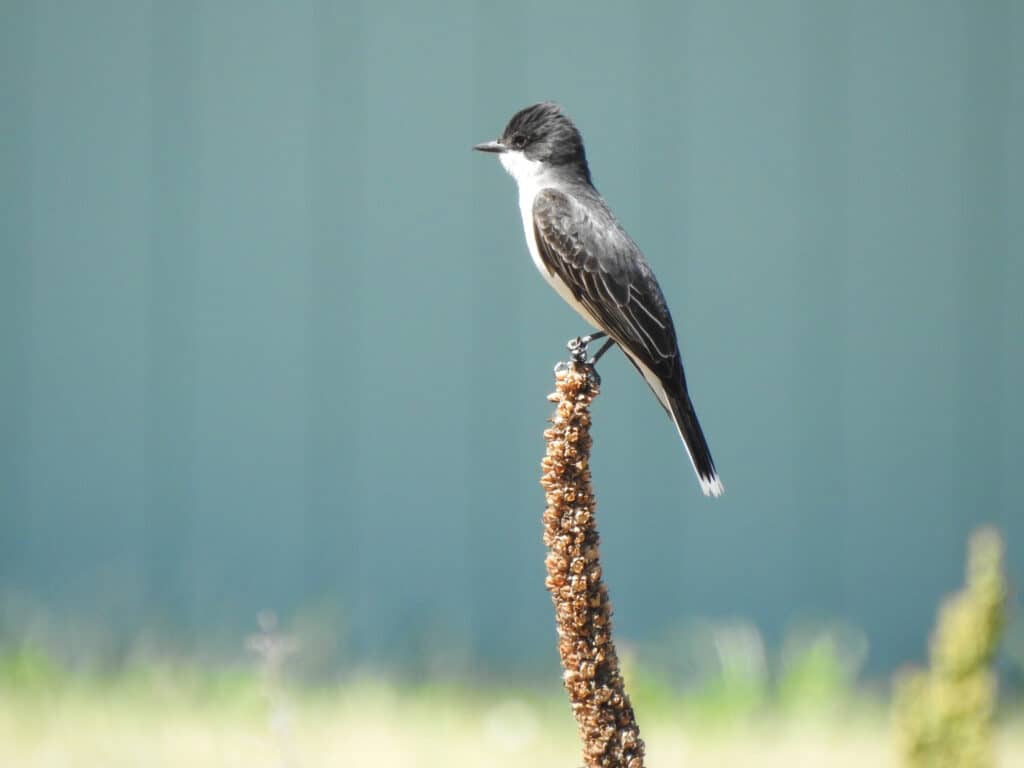Eastern Kingbird
Tyrannus tyrannus
The eastern kingbird is a fierce fighter once known as the butcher king!
Advertisement
Eastern Kingbird Scientific Classification
- Kingdom
- Animalia
- Phylum
- Chordata
- Class
- Aves
- Order
- Passeriformes
- Family
- Tyrannidae
- Genus
- Tyrannus
- Scientific Name
- Tyrannus tyrannus
Read our Complete Guide to Classification of Animals.
Eastern Kingbird Conservation Status
Eastern Kingbird Facts
- Prey
- Insects
- Main Prey
- Insects
- Name Of Young
- Chicks
- Fun Fact
- The eastern kingbird is a fierce fighter once known as the butcher king!
- Estimated Population Size
- 26,000,000
- Biggest Threat
- Habitat loss
- Most Distinctive Feature
- White tips on tail feathers
- Distinctive Feature
- Grey body, white underparts, black head, black feet, short and pointed black beak, black eyes
- Other Name(s)
- Tyrannus tyrannus
- Temperament
- Aggressive
- Wingspan
- 13 to 15 inches
- Incubation Period
- 14 to 17 days
- Age Of Fledgling
- 16 to 17 days
- Habitat
- Open areas with trees and shrubs
- Predators
- Blue jays, crows, squirrels, snakes, American kestrels
- Diet
- Omnivore
- Lifestyle
- Pair
- Favorite Food
- Insects
- Type
- Large flying insects
- Common Name
- Eastern kingbird
- Number Of Species
- 1
- Location
- North America, Central America, South America
- Average Clutch Size
- 4
- Nesting Location
- In trees, on poles, posts or stumps, and even in open fields
- Migratory
- 1
View all of the Eastern Kingbird images!
This eastern kingbird is mostly monochromatic, just black, dark gray, and white, but it has a secret under its cap. Beneath the velvety black feathers on its head, there is a brightly colored crown of red, orange, or yellow. It only shows this impressive crown when it has a good reason, such as courting a potential mate or challenging a predator or foe. This fierce little bird may be only the size of a robin, but it won’t hesitate to take on much larger birds, snakes, or other animals that threaten its territory.
This flycatcher is a deadly hunter, catching large insects on the fly or diving down to snatch up terrestrial prey. This bird loves to be near the water, and migrates thousands of miles each year from its breeding grounds as far north as Canada to its winter range as far south as Argentina. Look for its white-tipped tail and listen for its metallic “dzeet dzeet” call in open or lightly wooded areas across North America from spring through fall.
Incredible Eastern Kingbird Facts
- These birds are fierce fighters, taking on foes much larger than themselves and often winning.
- DNA studies show that eastern kingbirds, though mostly monogamous, are prone to cheating.
- The tail feathers of these birds look like they have been dipped in white paint.
- Eastern kingbirds almost never walk or hop. They prefer to fly everywhere.
- These birds hide their colorful crown underneath black feathers, and only show it when they have a good reason.
Where to Find the Eastern Kingbird
This common flycatcher may be easy to spot throughout its breeding range. It hangs out in open areas, often perched on wires, fences, tree limbs or posts, looking for its next meal. In North America, the eastern kingbird is most often found in open areas like grasslands or marshes, near trees, although not usually deep in the forest. It typically lives near water, over which it easily catches prey and even sometimes builds its nests.
The range of the eastern kingbird is expansive, extending from northern Canada all the way to Argentina. The breeding territory of this bird includes most of the United States, except for parts of the southwest, and much of Canada except the far northern regions. It migrates through eastern Mexico and the Caribbean en route to its winter grounds in Central and South America. There, it is found primarily along the Amazon River basin where it lives within tropical forests.
During migration, the bird can be found in more diverse habitats, including deeper in forests and farther away from water.
Eastern Kingbird Scientific Name
The eastern kingbird is a flycatcher in the Tyrannidae family. This family, filled with a wide variety of flycatchers, is the largest family of birds with more than 430 known species.
This particular flycatcher was first described by Linnaeus in 1758. He assigned the name Lanius tyrannus — which translates roughly to “butcher king” — to the bird. In 1799, French naturalist Bernard Germain de Lacépède reassigned the bird to the Tyrannus genus. The eastern kingbird is the type species of said genus, and one of 13 species that comprise it, most of which are called kingbird.
Eastern Kingbird Appearance

Eastern kingbirds are about the size of an American robin.
©iStock.com/Emily Jackson Photography
This bird is approximately the size of an American robin. Males and females look similar, except that males can be a little larger. Adults grow to about 7.7 to 9.1 inches in length and can attain weights of 1.2 to 1.9 ounces. Their lovely, fan-shaped wings extend to around 13 to 15 inches.
The eastern kingbird is striking, but somewhat monochromatic in appearance. Its body is mostly dark gray with clean, white feathers on its underparts. The long tail feathers are each tipped in bright white, as if they’d been dipped in paint. They make a distinctive display when the tail is fanned out in flight. This flycatcher has a large, black, or very dark gray head with deep, black eyes, and a short, pointy black bill. Its feet are also black.
This flycatcher seems to have been painted all in grayscale, except for the one splash of color it conceals most of the time. On the bird’s crown, hidden underneath its dark feathers, there is a small crest of red, red-orange, or even sometimes yellow. When the bird is agitated, it can raise these feathers to create a startling and distracting display. Males, especially, are likely to flash their colorful crowns when engaging predators or other foes.
Eastern Kingbird Behavior
This migratory bird spends its summers in North America and its winters in Central and South America, migrating in flocks back and forth each year. During its breeding season, it spends much of its time hunting, but in the winter it is mainly a foraging bird.
The eastern kingbird is fiercely aggressive. Its original scientific name, Lanius tyrannus, means “butcher king” and is a reference to the bird’s vicious predatory style. It is known for catching large insects in midair and bashing them to death against a hard surface before gobbling them up.
This small bird is equally aggressive with other birds. It attacks much larger birds, including blue jays and crows, especially in defense of its nest. It is highly territorial and will fight other birds, including rivals of the same species. When eastern kingbirds fight one another, they lock their feet together and try to rip each other’s feathers out, sometimes plummeting to the ground in full combat rather than submitting to defeat.
After breeding season, eastern kingbirds become quite social. They migrate together in flocks from a few dozen up to thousands of birds without exhibiting much aggression toward one another at all. In the spring, once they return to their northern range, all bets are off.
Diet
The eastern kingbird is a flycatcher from the Tyrannidae family. Its diet consists mostly of insects that it catches in midair. It prefers large flying insects, such as bees, wasps, grasshoppers, and beetles. However, it is also adept at hunting insects on the ground or surfaces of plants, such as ants or terrestrial bugs. The bird often does this by hovering in the air and then swooping in on its prey.
Berries, fruits, and seeds are also an important part of the eastern kingbird’s diet. This omnivorous bird eats more and more plant-based foods as it prepares for migration. Once it reaches its winter home, it depends largely on berries and other vegetation.
Eastern Kingbird Reproduction
Male and female eastern kingbirds form mostly monogamous pairs. Evidence from DNA testing, however, indicates that these pairs are not entirely faithful to one another. Males usually work to attract a female to a territory they favor. They perform acrobatic dances in the air, hovering and darting, and raise their colorful crown feathers in courting displays. When a female chooses her mate, she proceeds to pick a nest location, often within the area suggested by the male she has selected.
The female builds a cup-shaped nest, usually in a lone tree. The nest is made of twigs, dried grass and weeds, pieces of stripped bark, and even trash. The male stays close by and guards the territory while the female is busy building the nest. She lines the middle of the nest with soft plant fibers and animal hair. Then she lays about two to five small eggs, each about an inch long.
Incubation takes approximately 14 to 17 days. The nestlings fledge around 16 or 17 days later. The female incubates and broods the young, and she does most of the feeding as well. Males do help with feeding the nestlings insects, both before and for about five weeks after they fledge. During that time, the parents usually watch over the young in a cluster of trees somewhere near the nest.
Eastern kingbirds have only one brood per year, unless their nest is destroyed early. In that case they will sometimes make another attempt. The pairs are extremely aggressive in defending their nests. Because they nest in relatively open areas, and so many of their nests get destroyed by predators, they need to be fierce to increase the chances that their offspring will survive.
Predators
Blue jays, crows, and the American kestrel are all common predators of the eastern kingbird. However, this feisty flycatcher does not go down without a fight. It has been known to attack much larger birds and win, due to its highly aggressive tendencies and amazing maneuverability in the air.
Nest predators, such as snakes and squirrels are particularly deadly foes. According to research, more than 50 percent of eastern kingbird nests are destroyed by nest predators. Female adults, which spend much more time at the nest than males, also have a shorter life expectancy.
Both male and female adults work hard to protect their nests from predators. They will put on defensive displays, hovering and diving at their opponents, opening their mouths wide and raising their brightly colored crowns. They won’t hesitate to attack a predator that is threatening them or their offspring. If their nest is destroyed by predators, the breeding pair may make another attempt, usually within the same nesting territory.
Nest Parasitism
Another threat to eastern kingbirds, common to many songbirds, is nest parasitism by the brown headed cowbird. This lazy bird lays its eggs in the nests of other species, then goes on its way leaving them to raise its young. Fortunately, the eastern kingbird is not easily suckered. When it recognizes the cowbird’s eggs as different from its own pale eggs ringed with red spots, it pierces their membranes, causing them to die.
Lifespan of the Eastern Kingbird
The average lifespan of an eastern kingbird is less than 3 years with the longest living specimens reaching about 10 years of age. Males tend to live a few months longer than females on average. This is possibly due to the fact that predation at the nest is especially high, and females are the ones who spend most of the time at the nest.
Currently, approximately 26 million eastern kingbirds exist, and they are listed as a species of least concern on the IUCN Red List. However, their numbers have been slowly but steadily decreasing since the 1960s. Researchers believe that a combination of factors, including habitat destruction and pesticide use, may have contributed to the decline in this species.
Related Animals…
- Vermilion Flycatcher – This vibrant red and black member of the Tyrannidae family is found mainly in South America and southern North America.
- Eastern Phoebe – This small gray and white flycatcher was named for its call. It sounds like it is saying, “Phoebe! Phoebe!”
- Great Kiskadee – The great kiskadee is one of the largest of the flycatchers in the Tyrannidae family. It is known for its yellow belly and black and white striped head.
Eastern Kingbird FAQs (Frequently Asked Questions)
What does the eastern kingbird look like?
The eastern kingbird is dark gray with clean white underparts and a velvety black head. Its tail feathers are tipped with white and look as if they were dipped in paint. It has black feet, a short and pointed black bill, and black eyes. It has a concealed colorful crown that is red, orange or yellow, which it can flash like a crest when it chooses.
How many varieties of eastern kingbirds exist?
There is only one variety of eastern kingbird. It is the only species in the Tyrannus genus.
What makes the eastern kingbird special?
The eastern kingbird is a vicious fighter that is not afraid to take on much larger foes in defense of its territory. They will even fight other members of their own species, locking together by their feet and yanking at each other’s feathers, sometimes plummeting to the ground in combat.
What is the habitat of eastern kingbirds?
Eastern kingbirds prefer to live in open areas with sparse trees, near the edges of forest, around grasslands or marshes, and usually near water. They nest in lone trees, and usually move their fledglings to a nearby cluster of trees for a few weeks before they disperse. In the winter, they migrate to tropical forests.
Where eastern kingbirds live?
Eastern kingbirds have a vast range. Their breeding grounds include most of the United States, except for parts of the southwest, and Canada, except for the northern reaches. They migrate through Eastern Mexico and the Caribbean to their winter grounds in Central and South America, primarily along the Amazon River basin.
What do eastern kingbirds eat?
Eastern kingbirds primarily eat insects and other prey during their breeding season. They prefer large insects that they catch in midair, but they will also prey on insects on the ground or on the surfaces of plants. They begin to eat more seeds and berries as they prepare to migrate, and plant-based foods make up most of their diet during the winter.
How long do eastern kingbirds live?
Most eastern kingbirds live fewer than three years, but they have been known to live up to 10 years or more. Female birds have a shorter estimated lifespan than males, possibly because they are the primary caretakers of the nest, and more than 50 percent of eastern kingbird nests are destroyed.
Are eastern kingbirds rare?
Eastern kingbirds are not rare. The IUCN Red List designates them as a species of least concern, with an estimated population of 26 million birds. They have experienced slow but steady decline since the 1960s, losing more than 40 percent of their total numbers in just a few decades, and that is definitely a reason for concern.
What threats do eastern kingbirds face?
Researchers say habitat loss and pesticide use are both likely threats to the eastern kingbird population. Nest predators such as domestic cats, squirrels, snakes, and predatory birds also take a significant toll on the reproductive success of this bird.
Thank you for reading! Have some feedback for us? Contact the AZ Animals editorial team.
Sources
- eBird, Available here: https://ebird.org/species/easkin
- Oxford Academic, Available here: https://academic.oup.com/auk/article/124/3/1010/5562706
- New York State Ornithological Association, Available here: https://nybirds.org/KB_IssuesArchive/y2014v64n4.pdf
- International Union for Conservation of Nature Red List, Available here: https://www.iucnredlist.org/species/22700506/137917704
- Holden Arboretum, Available here: https://holdenfg.org/nature-profiles/eastern-kingbird/

















